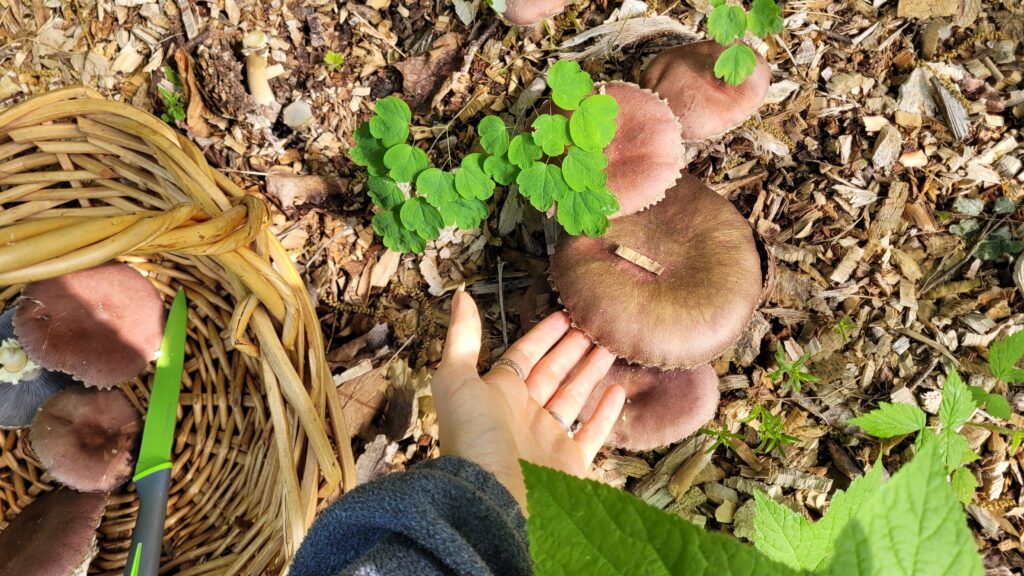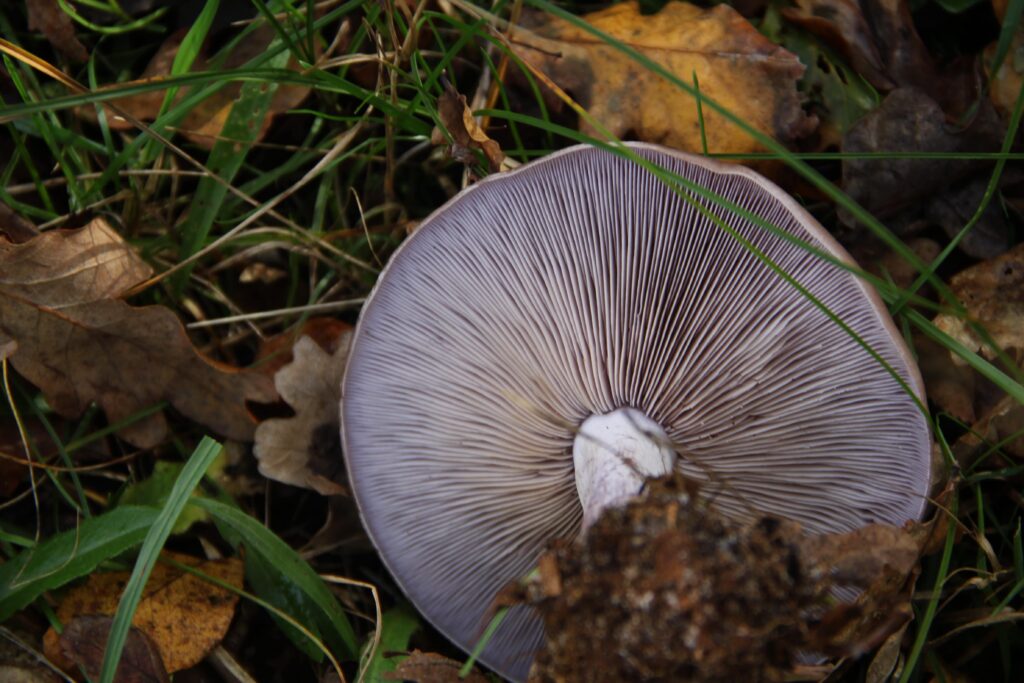This post may contain affiliate links. If you use these links to buy something we may earn a commission. Thanks.
Several wood-loving mushrooms grow best in piles of woodchips, otherwise known as “mushroom beds.”
Mushroom beds are a pile of moist organic material, such as woodchips and other mixed mediums, that have had mushroom mycelium introduced. Once introduced, mycelium colonizes the mediums, otherwise known as substrate and fruiting occurs when conditions, like temperature, are ideal.
Beds are the most accessible way to grow mushrooms outside and woodchips grow a variety of edible and delicious fungi.
King Stropharia (wine cap), oyster, chestnut, blewit, nameko, and morel mushrooms grow best in woodchip beds. Some strains are easier to cultivate than others, but each produces best with access to woodchips. Other substrates, such as straw or manure, are often mixed in to fast-forward fruiting.
Step one: Grow a Mushroom Garden at Home in 4 Steps

Besides being easy to obtain, mushroom yield and longevity are what make woodchips a popular medium in mushroom beds. Woodchips require less maintenance as they last longer than straw. Straw, however, produces fruiting bodies quicker than woodchips but is also consumed much faster.
Mixing straw with woodchips results in both fast-acting and long-lasting mushrooms. We mix the two every time!
Each of these wood-loving mushrooms offers unique flavors, textures, and cultivation levels. Keep reading to figure out which ones you’ll prefer to grow!
For beginners, mushroom beds are about as cheap as cultivation gets—see: 6 Ways to Grow Mushrooms at Home (Compared).
King Stropharia (Wine Cap)

If you’re a beginner at growing mushrooms and this is the first wood chip bed you’ve ever done—wine cap mushrooms won’t disappoint.
Wine cap mushrooms are the all-time easiest to grow in woodchips and grow large fruit, in large amounts.
What are wine cap mushrooms like?
The cap color ranges from brown, or beige, to a pale wine red. The gills and spore print are a dark purple ‘ink’ color and the stems are white.
We enjoy the taste and texture of the large caps, especially fresh off the barbecue. Large stems can taste a bit fungus-y so we either cut them into thin disks or discard excessive stems.
What are the best woodchips for wine caps?
Woodchips are often assorted and unidentifiable wood, and wine cap mushrooms tend to grow easily on any pile of chips. Some types of wood, however, make better substrates for wine caps than others.
Deciduous soft hardwoods, such as willow, poplar, basswood, and paper birch, are ideal for establishing wine cap mushrooms in beds. They’ll also grow on harder hardwoods such as oak, beech, hard maples, and more. Coniferous softwoods can be in the mix but won’t yield the best results on their own.
Hardwoods tend to be more friendly to gourmet mushrooms than softwoods. Learn more: How to Identify & Select Trees for Mushroom Logs (With Pics)
Wine caps grow best on woodchips and don’t grow on logs.
Oysters

Oyster mushrooms thrive on all kinds of substrates and woodchips are one of them!
Depending on your climate, you’ll be able to grow several oyster mushrooms outside in mushroom beds.
Blue, pink, golden, snow, and Italian oyster mushrooms grow in woodchip beds. Poplar, willow, aspen, cottonwood, and tuliptree are the best tree species to use for oyster mushroom woodchips. If other hardwoods happen to be in the mix, that’s okay too.
Straw is also a popular mushroom bed substrate for oyster mushrooms. I recommend using a mix of both.
Cold climate areas (zones 3-8) can grow cold-tolerant oyster mushrooms such as Italian, snow, and blue. Zones 6-8 should place mushroom beds in a cool, shady, and humid area. Zones 3-5 should situate beds where it’s moist and protected from winter wind and may receive some sun.
Italian oyster mushrooms fruit at 65-75°F (18-24°C) and tolerate winters when protected.
- Grain spawn is used to make straw or woodchip beds
- Sawdust spawn is used to make logs (in bulk) or beds
Snow oyster mushrooms fruit between 45-65°F (7-18°C) and tolerates winters.
- Grain spawn is used to make straw or woodchip beds
- Sawdust spawn is used to make logs (in bulk) or beds
Blue oyster mushrooms fruit at 55-75°F (13-24°C) and tolerate winters.
- Grain spawn is used to make straw or woodchip beds
- Sawdust spawn is used to make logs or beds
Warm climate areas (zones 9 and above) can grow heat-loving mushrooms.
Pink oyster mushrooms fruit at 70-80°F (21-26°C) and don’t tolerate cold climate winters.
- Gain spawn is used to make straw or woodchip beds
- Sawdust spawn is used to make logs (in bulk) or beds
Golden oyster mushrooms fruit between 65-80°F (18-26°C) and aren’t cold tolerant.
- Grain spawn is used to make straw or woodchip beds
- Sawdust spawn is used to make logs (in bulk) or beds
Chestnut

Chestnut mushrooms are lesser-known, but so flavorful, that those who grow them consider them one of the best-tasting mushrooms. The unique taste is described as rich, earthy, and nutty.
If they were as easy to grow as wine caps and oysters, they’d likely be more popular, but chestnuts take intermediate skill.
Woodchips from healthy hardwood trees are best for growing chestnut mushrooms in beds. Maple, oak, beech, or birch are ideal hardwoods for chestnut woodchip beds. Old or softwood woodchips aren’t suitable for making chestnut mushroom beds.
Cut down healthy hardwood trees 2-4 weeks prior to chipping the wood and you’re likely to have successful chestnut mushroom beds. The key is good wood and consistent moisture.
Blewit

Blewit mushrooms are lavender-colored meaty mushrooms. Their taste is described to be somewhat sweet, mild, woody, and mushroomy with a dash of pepper.
Blewit mushrooms grow best in a mixed-medium substrate including hardwood woodchips, bark, straw, corn stalks, manure, leaves, grass clippings, compost, sticks, and more. The more materials you add to the bed, the better, as confirmed by Field and Forest mushroom growers.
Myco Boutique recommends making a substrate made up of 8 parts:
- hardwood shavings x1
- dead leaves x2
- manure x4
- straw x1
Ensure all ingredients are chemical-free and keep your blewit mushroom bed moist. Results should fruition within 6-12 months. Blewit mushrooms tend to fruit in cooler temperatures from 45-70°F (7-21°C).
Since blewit mushrooms are “top fruiting” they grow best in beds, and don’t grow on logs at all.
Nameko

Nameko mushrooms a small, shiny, and butterscotch brown. Generally, they are known for their gelatin-like coating and are described as tasting earthy with subtle fruity hints, and have an aroma like cashews.
The tricky part about growing nameko mushrooms is stable fruiting conditions. Nameko mushrooms need cool temperatures of 45-65°F (7-18°C) and consistent humidity to fruit. Hot or dry climates aren’t suitable for growing these outdoors in mushroom beds.
The Biology and Cultivation of Edible Mushrooms mentions (p. 492) “Nameko… needs more moisture for fruiting compared with other cultivated mushrooms.”
If you live in a humid climate, nameko mushrooms are worth an experiment! For best success use woodchips made from healthy trees like alder, aspen, basswood, beech, birch, cherry, chestnut, cottonwood, maple, oak, or willow.
Once you inoculate your woodchip bed with nameko mushroom spawn it takes from 2-4 months before they are ready to set fruit. Once conditions outside are ideal they will pin, and if suitable conditions continue, they will fruit.
Morel

Morel mushrooms are one of the most popular and prized finds for foragers. The fun news is they are cultivatable, but very difficult and essentially experimental for growers with the right environment.
They look like pointy brains and are hollow inside.
Sauteed in a pan with salt and pepper, they almost melt in the mouth with a slight chew. We love them.
We have naturally occurring morel mushrooms in multiple parts of our property. One is on the driveway by the garage, two is up the driving on the edge of the forest, and three is beside the house in the forest, all the way down toward the water.
Fun fact, I found a morel bigger than a baseball by the garage once, but unfortunately too old to harvest. Our morels pop up in the cool temperatures of May after a rainy period.
They appear to do well in recently disturbed areas and under deciduous hardwood trees. Ours are growing under oak, beech, poplar, ash, basswood, and more. The floor has rich soil and plenty of woody debris.
If you can simulate an environment like that with hardwood chips and good compost under healthy hardwood trees, maybe you’ll increase the odds of success.
As the forest turns into cedars and pines closer to the water, they are no longer sited. So avoid making morel mushroom beds under softwood or evergreen trees.
If you definitely want a harvest of mushrooms, however, I recommend sticking to the first 3 species of this post, as a start.
Up Next: What is a Mushroom Bed? (When to Start & Where to Put it)
Recent Posts
There’s no shortage of full-sun ground covers for zone 4 climates! Each plant in this list can withstand the frigid temperatures and also enjoy the hot sun in summer. Full sun means that a plant...
There's no shortage of full sun ground covers, not even in zone 3! Zone 3 climates offer hot but short-lived summers and very cold winters. So each plant in this list can withstand the frigid...
